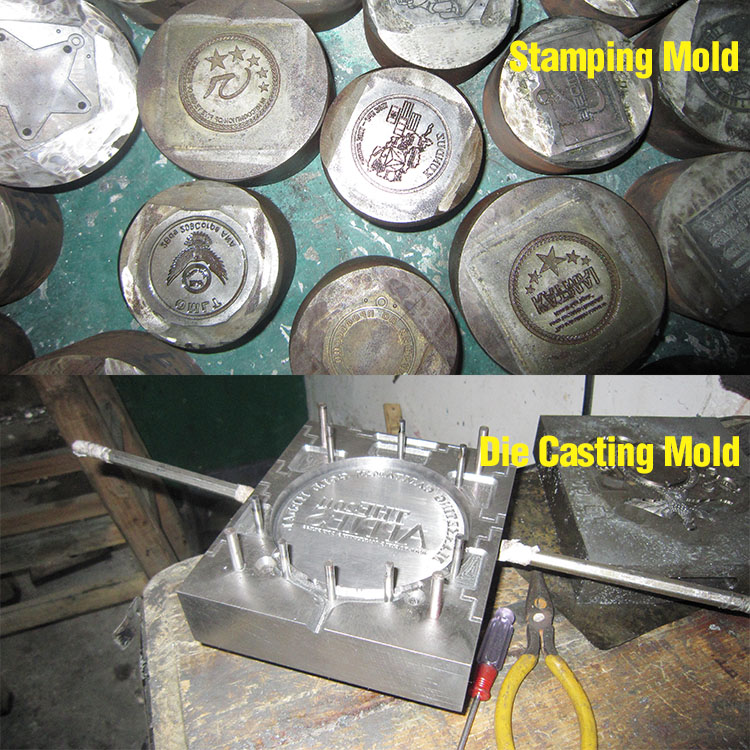Badge production processes are generally divided into stamping, die-casting, hydraulic pressure, corrosion, etc. Among them, stamping and die-casting are more common. Color treatment and coloring techniques include enamel (cloisonné), imitation enamel, baking paint, glue, printing, etc. The materials of badges are generally divided into zinc alloy, copper, stainless steel, iron, pure silver, pure gold and other alloy materials.
Stamping badges: Generally, the materials used for stamping badges are copper, iron, aluminum, etc., so they are also called metal badges. The most common ones are copper badges, because copper is relatively soft and the pressed lines are the clearest, followed by iron badges. Correspondingly, the price of copper is also relatively expensive.
Die-cast badges: Die-cast badges are usually made of zinc alloy materials. Because the zinc alloy material has a low melting point, it can be heated and injected into the mold to produce complex and difficult relief hollow badges.
How to distinguish zinc alloy and copper badges
Zinc alloy: light weight, beveled and smooth edges
Copper: There are punch marks on the trimmed edges, and it is heavier than zinc alloy in the same volume.
Generally, zinc alloy accessories are riveted, and copper accessories are soldered and silvered.
Enamel badge: Enamel badge, also known as cloisonné badge, is the most high-end badge craft. The material is mainly red copper, colored with enamel powder. The characteristic of making enamel badges is that they must be colored first and then polished and electroplated with stone, so they feel smooth and flat. The colors are all dark and single and can be stored permanently, but the enamel is fragile and cannot be knocked or dropped by gravity. Enamel badges are commonly found in military medals, medals, medals, license plates, car logos, etc.
Imitation enamel badges: The production process is basically the same as that of enamel badges, except that the color is not enamel powder, but resin paint, also called color paste pigment. The color is brighter and glossier than enamel. The surface of the product feels smooth, and the base material can be copper, iron, zinc alloy, etc.
How to distinguish enamel from imitation enamel: Real enamel has a ceramic texture, less color selectivity, and a hard surface. Punching the surface with a needle will not leave traces, but it is easy to break. The material of imitation enamel is soft, and a needle can be used to penetrate the fake enamel layer. The color is bright, but it cannot be stored for a long time. After three to five years, the color will turn yellow after being exposed to high temperature or ultraviolet rays.
Paint process badge: obvious concave and convex feeling, bright color, clear metal lines. The concave part is filled with baking paint, and the protruding part of the metal lines needs to be electroplated. The materials generally include copper, zinc alloy, iron, etc. Among them, iron and zinc alloy are cheap, so there are more common paint badges. The production process is electroplating first, then coloring and baking, which is opposite to the enamel production process.
The painted badge protects the surface from scratches in order to preserve it for a long time. You can put a layer of transparent protective resin on its surface, which is Polly, which we often call “dip glue”. After being coated with resin, the badge no longer has the concave and convex texture of metal. However, Polly is also easily scratched, and after exposure to ultraviolet rays, Polly will turn yellow over time.
Printing badges: usually two ways: screen printing and offset printing. It is also generally called a glue badge because the final process of the badge is to add a layer of transparent protective resin (Poly) to the surface of the badge. The materials used are mainly stainless steel and bronze, and the thickness is generally 0.8mm. The surface is not electroplated, and is either natural color or brushed.
Screen printing badges are mainly aimed at simple graphics and fewer colors. Lithographic printing is aimed at complex patterns and many colors, especially graphics with gradient colors.

Post time: Oct-19-2023





